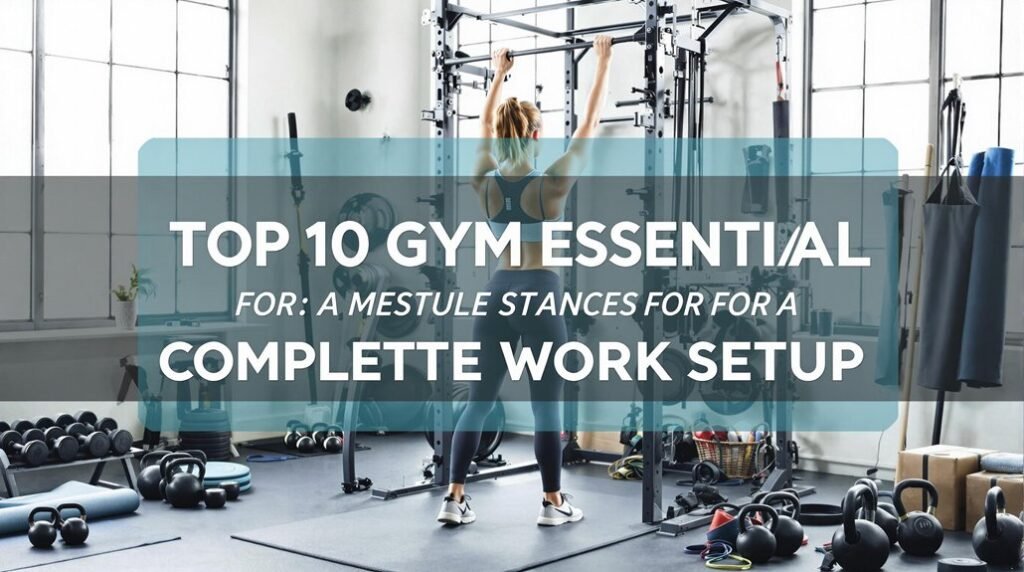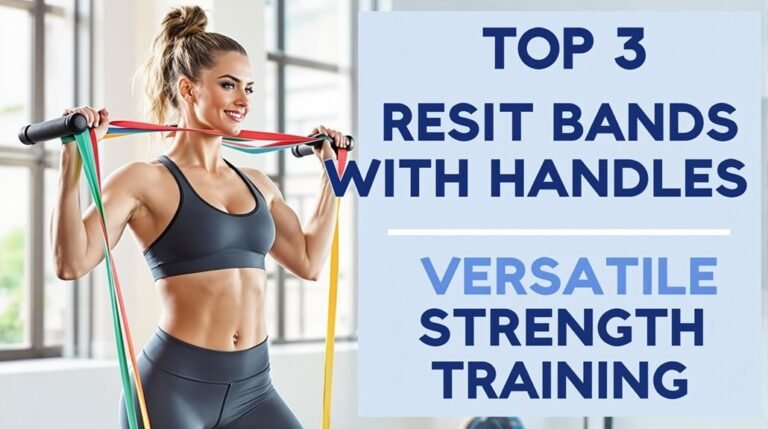To build a complete home gym, you'll need these 10 essential pieces: a power rack with safety features for heavy lifting, an adjustable workout bench that supports up to 1,000 pounds, a quality Olympic barbell with weight plates, adjustable dumbbells for space efficiency, resistance bands in various tensions (10-50+ lbs), a thick exercise mat (1/2 to 3/4 inch), stability tools like balance balls, recovery equipment including foam rollers, smart storage solutions like wall-mounted racks, and basic cardio equipment such as a foldable treadmill or compact elliptical. Understanding how to properly set up and maintain these fundamentals will reveal your full training potential.
Key Takeaways
- A power rack with safety features and appropriate height clearance forms the foundation of a safe and effective strength training setup.
- Adjustable dumbbells save space while providing versatile weight options for various exercises and progressive overload training.
- An adjustable workout bench with multiple positions enables diverse exercise options and supports proper form during workouts.
- High-quality floor mats protect both equipment and flooring while providing necessary cushioning for different exercise types.
- Recovery equipment like foam rollers and resistance bands complement strength training gear for a well-rounded fitness approach.
Essential Free Weights
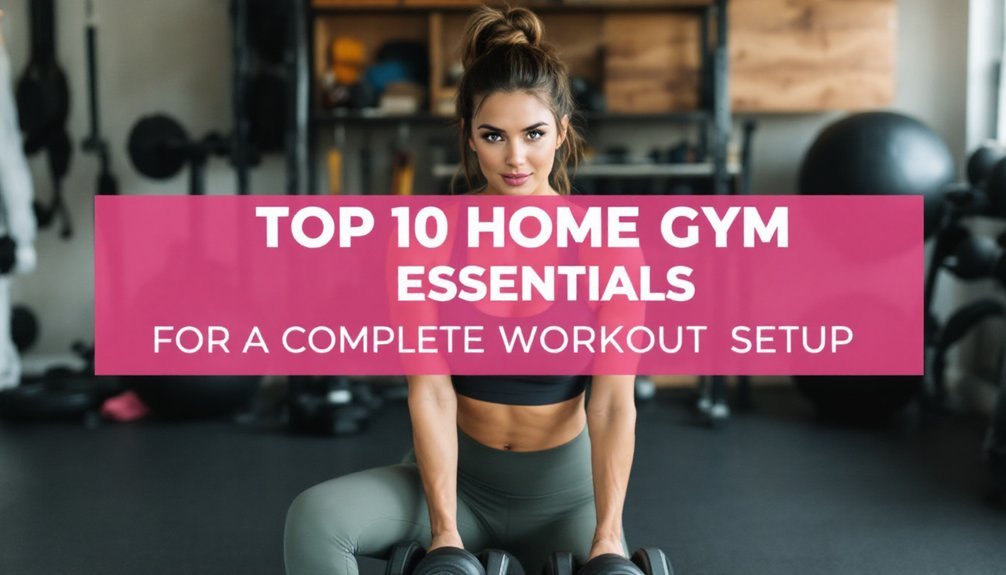
Essential Free Weights
Free weights are fundamental building blocks for any home gym setup. When you're looking to maximize your workout potential, understanding free weights benefits is essential. They help develop functional strength, burn more calories through compound movements, and improve muscle balance through stabilization exercises. With options for free shipping within 48 states, setting up your home gym is more accessible than ever. Using tools like resistance bands can further enhance your strength training routine.
The most important free weights types you'll need include dumbbells, kettlebells, and barbells. Dumbbells offer versatility for exercises like overhead presses and rows, while kettlebells excel at dynamic movements such as swings and Turkish get-ups. Barbells are perfect for heavy compound lifts like squats and deadlifts. Consider starting with adjustable dumbbells to save space and money, then gradually expand your collection based on your fitness goals. Remember to include proper storage solutions and protective flooring for your equipment.
Adjustable Workout Bench
When choosing an adjustable workout bench for your home gym, you'll want to evaluate its adjustment options, which typically include flat, incline, and decline positions to support a variety of exercises. Your bench should fit comfortably in your available space while offering stability and proper weight capacity, with most quality benches supporting between 600-1,000 pounds of total weight. Additionally, many of the best models feature multi-function capabilities, allowing you to perform a wide range of exercises without needing multiple pieces of equipment. The space-saving features, such as a foldable design and compact footprint, make an adjustable bench particularly valuable for home gyms where you need to maximize your workout area. The bench's versatility enables users to perform varied exercise routines from bench presses to dumbbell rows, making it an essential piece of equipment for comprehensive strength training.
Features and Adjustment Options
Selecting an adjustable workout bench with the right features can make or break your home gym experience. Look for adjustment mechanisms that offer multiple back angles, from decline (-10°) to incline (85°), allowing you to target specific muscle groups effectively. You'll want a bench that includes various seat positions, typically ranging from 0° to 30°, for ideal support during exercises.
When choosing your bench, prioritize models with high-density foam padding and 11-gauge steel construction, which guarantees both comfort and durability. The weight capacity should be at least 1,000 pounds to accommodate heavy lifts safely. For convenience, select a bench with transport wheels and a ladder-style adjustment system, making it easy to move and modify between exercises. A quality bench like the XMARK OX Series offers seven ladderback adjustments for optimal positioning during workouts. These features will help you maintain proper form while maximizing your workout variety.
Space-Saving Design Benefits
Beyond its impressive features, an adjustable workout bench's space-saving design makes it a standout choice for home fitness enthusiasts. You'll appreciate how its compact design optimizes space while maximizing workout efficiency, especially if you're dealing with limited square footage.
The bench's versatility shines through its foldable options and wall-mounted possibilities, letting you reclaim valuable floor space when it's not in use. Choosing a bench with built-in storage features helps minimize clutter while keeping workout accessories within easy reach. You'll find that despite its space-conscious design, you won't sacrifice exercise variety – you can still perform incline presses, decline flyes, and seated curls with ease. Whether you're a beginner or advanced user, the bench's adjustable angles support progressive overload training while maintaining a small footprint. It's a smart investment that guarantees sustainable fitness without overwhelming your home gym space.
Weight Capacity and Stability
Every serious home gym needs a reliable adjustable workout bench with robust weight capacity and stability features. When selecting your bench, you'll want one that's built with 11-gauge steel and can support up to 1,000 pounds of weight capacity, ensuring safe and effective workouts for years to come. A well-built bench features triangular mechanics construction for maximum stability during heavy lifts.
The best adjustable benches offer these essential stability features:
- Wide base with rubber feet to prevent slipping during intense workouts
- Three-post design for enhanced foot placement and structural integrity
- Secure adjustment system with multiple back pad positions (up to 9)
You'll find that a bench with these specifications provides the perfect foundation for exercises ranging from basic bench presses to advanced incline movements, with adjustments from 0 to 85 degrees. Remember, never exceed your bench's stated weight capacity to maintain safety.
Power Rack Setup
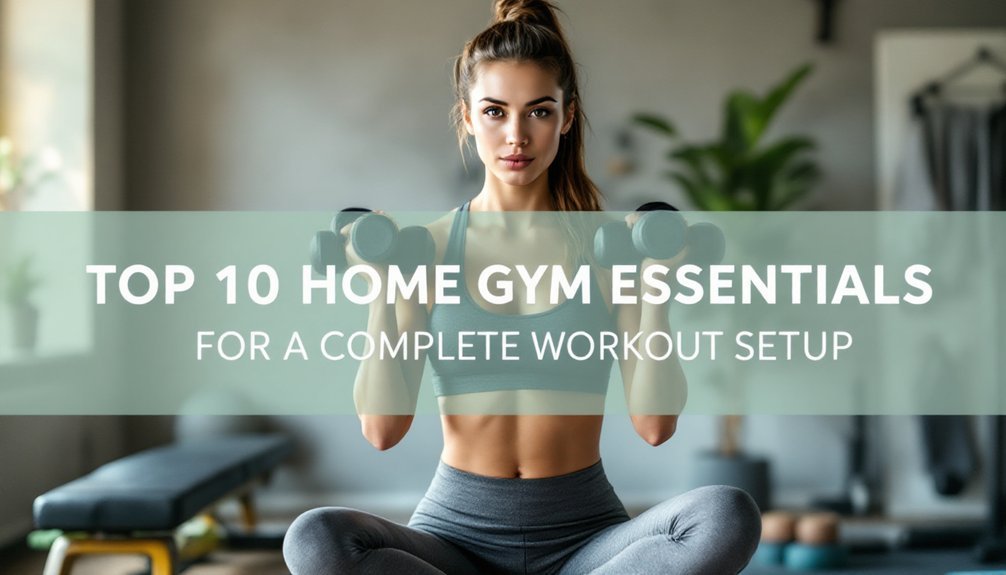
When setting up your power rack, you'll need to focus on two critical aspects: safety features and proper placement. Your rack should include adjustable safety bars and non-slip footplates, while additional accessories like a lat pull station or dip bars can expand your workout options. For ideal safety and functionality, position the rack in a stable location with at least 7-8 feet of ceiling clearance, and adjust the height so the bar rests at your shoulder level during squats. It's also advisable to choose a rack with safety features that meet industry standards for home gym equipment. Regular maintenance and inspection of the power rack components will help ensure safe workouts and extend the equipment's lifespan.
Safety Features and Accessories
A power rack serves as the cornerstone of any home gym's safety system, protecting you during heavy lifts and solo training sessions. When setting up your rack, verify proper safety bar adjustments and power rack stability by placing it on level ground and engaging all non-slip features. Most XMARK racks feature 11-gauge steel construction for superior durability and strength.
To maximize your safety while training, you'll need these essential accessories:
- J-cups and safety bars rated for at least 600 lbs capacity
- Flip-down or strap safeties for reliable barbell protection
- Spotter arms for additional support during heavy lifts
Regular maintenance of your power rack's components guarantees long-term safety. Check all pins, bolts, and attachments monthly, and immediately replace any worn parts. Remember to position weight storage pegs correctly to maintain the rack's stability during use.
Rack Height and Placement
Proper height and placement of your power rack determines both workout effectiveness and safety in your home gym. When selecting your setup, consider that standard rack dimensions range from 48-50 inches wide and deep, requiring at least 24 inches of exercise clearance on all sides for safe movement. High-quality flooring protection is essential underneath and around your power rack setup.
For ceiling height, you'll need significant overhead space. Most power racks stand 80-95 inches tall, and you should have at least 15 inches of additional clearance above the rack for overhead exercises. If you've got lower ceilings, consider compact models like the PR-1050, which stands at just 72 inches. Remember to account for extra space needed for attachments like plate holders or lat pulldowns, and guarantee your rack is properly anchored to the floor for stability during heavy lifts.
Quality Exercise Mat
Exercise mats serve as the foundation of any well-equipped home gym, offering essential support for your workouts while protecting both your body and floors. When selecting your mat, consider mat durability and mat thickness carefully – thicker mats (1/2 to 3/4 inch) provide better cushioning for high-impact exercises, while thinner options work well for yoga and stretching. Regular cleaning and maintenance helps prevent bacteria buildup and extends the lifespan of your mat. Choosing a mat with ultimate comfort and stability can enhance your workout experience significantly.
Choose your mat based on these key factors:
- Activity type – rubber mats for weightlifting and HIIT, foam mats for low-impact exercises
- Space requirements – interlocking tiles for larger areas, single mats for targeted zones
- Surface protection needs – thicker, more durable mats for areas with heavy equipment
You'll want to invest in a mat that matches your workout style and space constraints while providing adequate shock absorption and floor protection.
Resistance Bands Collection

Your resistance bands collection can transform basic workouts into extensive strength training sessions, with benefits ranging from improved muscle activation to enhanced mobility and injury prevention. When choosing your collection, you'll want bands offering different tension levels, from light (10-15 pounds) to heavy (50+ pounds), allowing you to target various muscle groups effectively and progress over time. Consider investing in a pack that includes a door anchor attachment for expanded exercise options. Additionally, ensure that the quality of materials used in your bands is high to guarantee durability and consistent resistance. Proper storage in a cool, dry place away from direct sunlight, along with regular inspection for wear and tear, will help maintain your bands' elasticity and extend their lifespan.
Benefits Beyond Basic Training
While basic training equipment forms the foundation of any home gym, resistance bands offer unique benefits that extend far beyond traditional workouts. You'll discover they're essential for functional fitness and injury prevention, while providing remarkable convenience benefits for your home gym integration.
Here's what makes resistance bands invaluable for your fitness journey:
- They enable precise resistance customization, perfect for muscle rehabilitation and post-workout recovery
- Their versatility promotes core activation through multiple planes of movement, enhancing overall stability
- You'll experience significant flexibility enhancement through controlled stretching exercises
The workout variety you'll achieve with resistance bands is unmatched, as you can easily combine them with other equipment or use them standalone for thorough strength training. Their portable nature guarantees you're never without an effective workout option, whether at home or traveling.
Types and Tension Levels
Building an extensive resistance band collection starts with understanding the various types and tension levels available to you. Your main options include therapy bands for rehabilitation, loop bands for full-body workouts, tube bands with handles that mimic gym equipment, mini bands for lower body work, and figure 8 bands for upper body exercises.
When selecting bands for resistance band exercises, you'll notice a color-coding system that indicates tension levels, typically progressing from yellow (lightest) to gold (heaviest). Each color increases resistance by about 25%, letting you gradually build strength. For maximum resistance band benefits, consider starting with a set of regular loop bands and mini bands, which offers versatility for $15-20. Loop bands provide 5-175 pounds of resistance, depending on width and thickness.
Storage and Care Tips
Proper storage and care of resistance bands can triple their lifespan while keeping your workout space organized. Invest in wall-mounted storage solutions with durable hooks to prevent tangling and maximize space efficiency. Regular maintenance tips include inspecting bands for wear, cleaning with mild soap, and ensuring they're completely dry before storage.
To extend the life of your resistance bands:
- Rotate your bands regularly to distribute wear evenly across your collection
- Install vertical storage systems at a comfortable height for easy access and organization
- Label your storage areas by tension level or exercise type for quick identification
Remember to clean your bands monthly and store them away from direct sunlight. A well-maintained resistance band collection not only performs better but also creates a more organized, professional-looking workout space.
Cardio Equipment Options
When setting up a home gym, cardio equipment represents one of the most important investments you'll make. Modern treadmill features include adjustable inclines up to 12%, pre-set programs, and cushioned decks to protect your joints, while elliptical benefits include low-impact, full-body workouts that are gentle on your knees and ankles.
You'll find several space-saving options that won't break the bank. Foldable treadmills and compact ellipticals like the Bowflex Max Trainer M9 help maximize limited floor space. For those with specific needs, recumbent bikes offer comfortable, low-impact workouts perfect for rehabilitation or senior fitness. If you're working with a tight budget, consider versatile equipment like rowing machines, which provide both cardio and strength training benefits while taking up minimal space.
Olympic Barbell and Plates

A high-quality Olympic barbell and weight plate set forms the foundation of any serious home gym setup. When selecting your equipment, focus on durability and functionality, ensuring your barbell can handle up to 1500lbs for intense training sessions. Regular barbell maintenance, including cleaning and lubricating the sleeves, will extend its lifespan considerably.
Consider these key factors when building your barbell setup:
- Choose between different plate materials like urethane or iron, based on your training style and noise concerns
- Verify the weight capacity matches your goals, with Olympic bars supporting heavier loads than standard bars
- Select appropriate knurling depth for your preferred exercises, noting that Olympic bars typically have medium-depth knurling
Remember to pair your barbell with a proper power rack and safety equipment for ideal training results.
Stability and Balance Tools
Beyond barbells and plates, stability and balance tools add an essential dimension to your home gym setup. When selecting your balance training techniques, you'll want to include versatile equipment like balance balls, balance pads, and parallette bars to develop core strength exercises effectively.
Start with a quality balance pad or stability ball, which offers an unstable surface to challenge your equilibrium and engage deep core muscles. As you progress, you can add more advanced tools like balance beams or performance pedestals. For limited spaces, consider compact options such as handstand blocks or resistance bands. You'll want to invest in equipment that matches your fitness level and goals while ensuring durability and safety. Remember to incorporate these tools gradually into your routine, combining them with your strength training for thorough workouts.
Recovery and Mobility Gear
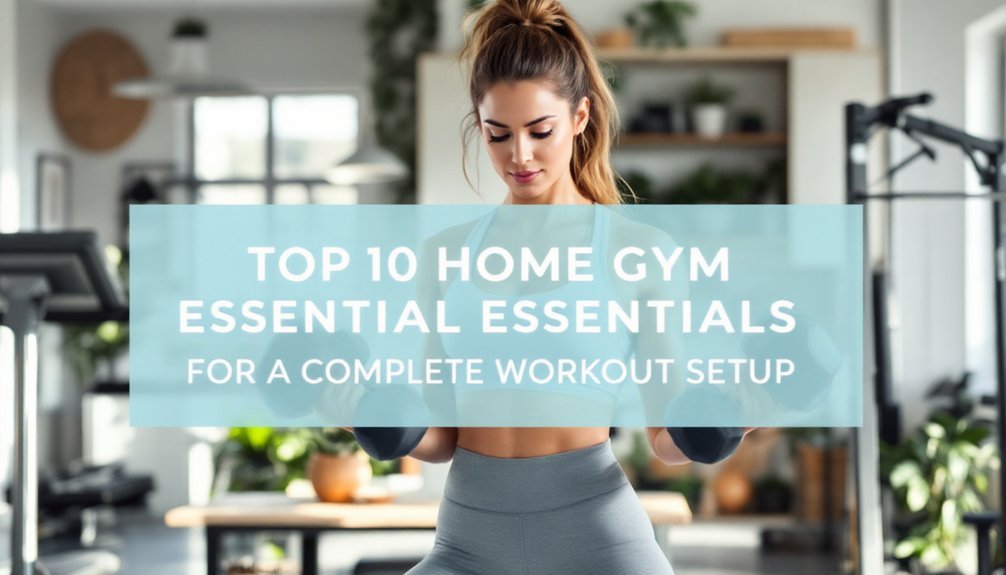
To maintain peak performance and prevent injury, your home gym setup must include essential recovery and mobility gear. Incorporating effective recovery strategies and mobility techniques will help you bounce back faster and prevent common workout-related injuries.
Here are three must-have recovery tools for your home gym:
- A high-quality foam roller for self-myofascial release, which helps loosen tight muscles
- Resistance bands for both dynamic stretching and mobility work
- A supportive yoga mat for proper stretching and floor exercises
Don't forget to complement your equipment with proper hydration and active recovery methods. Using mobility bands before workouts and massage rollers afterward will greatly improve your flexibility and reduce muscle soreness. When selecting recovery gear, consider durability and versatility to maximize your investment while meeting your specific fitness needs.
Smart Storage Solutions
Smart storage solutions serve as the backbone of any well-organized home gym, keeping your equipment secure and readily accessible. Through smart organization and space optimization, you'll maximize your workout area while maintaining a professional appearance. Invest in high-quality storage options that align with your specific needs and budget.
| Storage Type | Best For | Key Benefits |
|---|---|---|
| Wall-Mounted Racks | Dumbbells, Bars | Saves floor space |
| Vertical Towers | Kettlebells, Plates | Maximizes vertical space |
| Storage Bins | Small Equipment | Easy organization |
Your storage system should include a mix of racks, hooks, and shelving units to accommodate different equipment types. Consider installing wall-mounted solutions to free up valuable floor space, and opt for adjustable systems that can adapt as your gym equipment collection grows.
Frequently Asked Questions
How Often Should Home Gym Equipment Be Professionally Inspected and Maintained?
Like keeping your trusty car in shape, you'll need professional inspections once or twice yearly for peak equipment longevity, though high-use machines may require quarterly maintenance frequency for best results.
Can Multiple People Safely Share Home Gym Equipment Without Adjusting Settings?
You shouldn't share equipment without adjusting settings, as improper positioning can compromise user safety. Always readjust equipment to match your body size and fitness level before use.
What's the Ideal Room Temperature and Ventilation for a Home Gym?
Did you know 68°F is your sweet spot? You'll want to keep your home gym's ideal temperature between 65-68°F, with proper ventilation through HVAC systems, fans, or windows for ideal workouts.
Should Beginners Invest in Smart Fitness Equipment With Subscription-Based Training Programs?
You'll benefit from smart equipment's personalized guidance and convenience, but consider starting with basic equipment first and testing free fitness apps before committing to costly subscription programs.
How Long Does Home Gym Equipment Typically Last Before Needing Replacement?
Time flies with home gym equipment! You'll typically get 7-12 years from most pieces, though equipment lifespan varies. Watch for replacement signs like unusual noises, wear, or decreased performance.

